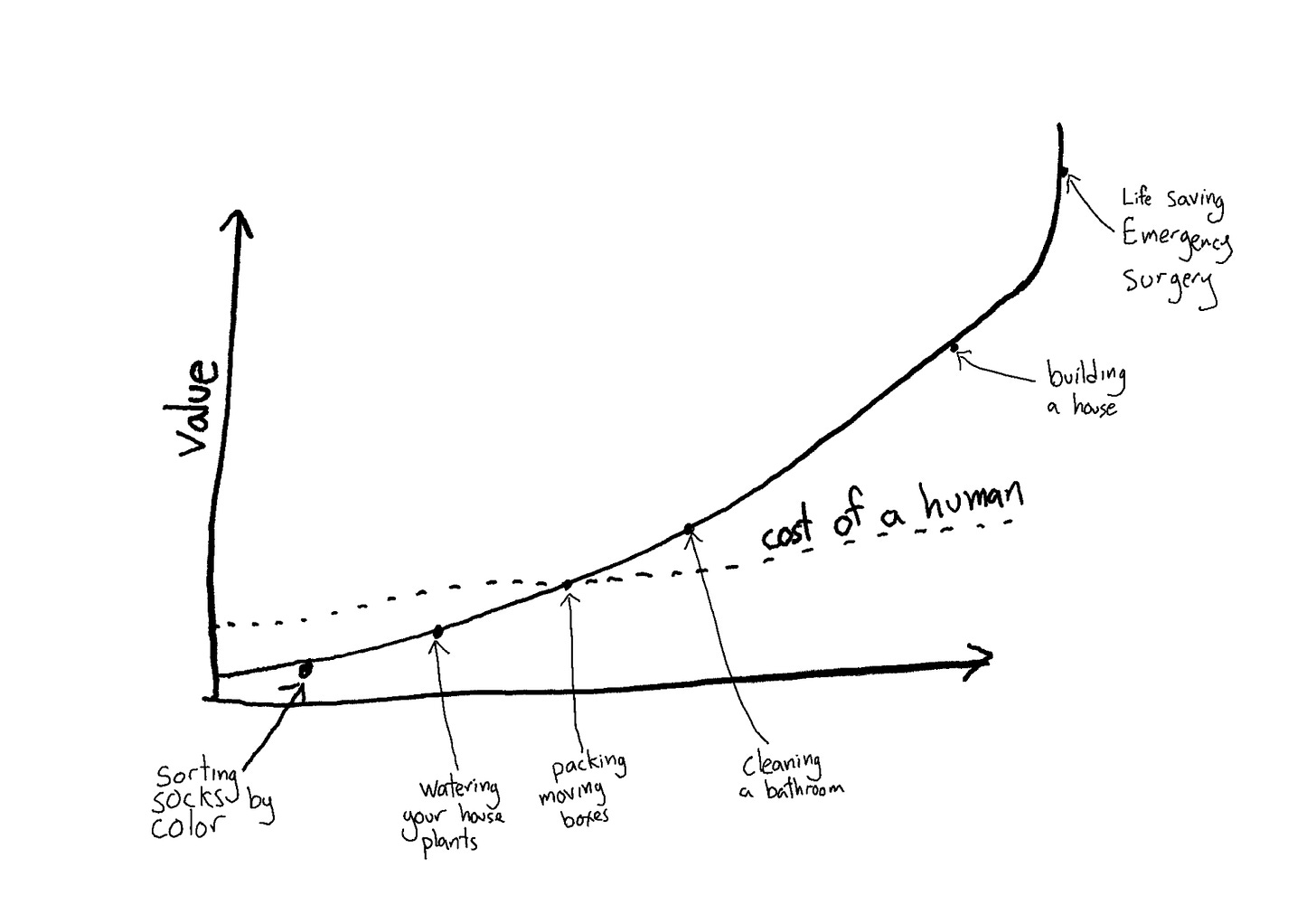Why Build a Robot Company?
So You Want To Do Robots: Part 1
About this series
I’ve been working on general purpose robots with Everyday Robots for 8 years, and was the engineering lead of the product/applications group until my whole team was impacted1 by the recent Alphabet layoffs. This series is an attempt to share almost a decade of lessons learned so you can get a head start making robots that live and work among us. In part one, we’ll talk about why to do robots in the first place.
Change the world
Economists talk about "land, labor and capital". For most of human history, the bottleneck on human flourishing has been land. With an agrarian economy there is a limit to the energy (calories) you can get out of cropland, and those calories are the limiting factor of your economy.
Sure, the 40 monks manually mining bitcoin eat most of our barley, but crypto is the future!
In the industrial revolution, fossil energy (and later solar-electric, hydro and nuclear) allowed humanity to explode outwards and live longer, and less desperate lives. The Industrial Revolution was not about an increase in productivity: it is a fundamental change in the limiting factor of the economy.
Robots remove the second bottleneck to human flourishing: labor2
To follow our analogy, industrial robots are the windmills and waterwheels of today: a toehold of the future that is expensive to set up and adapt to new tasks. They stay in niche industrial roles and make up a fraction of the work done. You want to build something like a steam engine, not a waterwheel. A steam engine is useful in many more applications and therefore able to unlock a huge change in the way work is done. But to do that, your robots need to do work where the work is: in human spaces. And they need to do it reliably enough and cost-effectively enough that they are worth using. Because once they are, economies of scale will make them better and cheaper (like cars or computers or tvs or steam engines) and the whole thing takes off. To light this rocket you need to make robots work in human spaces.
Be choosy in your ambitions
You don't even need all human spaces or dozens of applications. Rosie the robot, learning new tasks with no programming, and Artificial General Intelligence are all super-cool but not required.3
It cleans the floors, but can it pass the turing test?
You just need a few applications where you can make robots worth buying. The first steam engines ran water pumps in coal mines and spinning jennies for textiles, but those two applications were enough to start the cycle of compounding incremental improvements that enabled trains, then cars, then airplanes. Don’t make your ambition larger than it needs to be or your odds of success drop even closer to zero.
Yes, robots change jobs
If you do start a robot startup, though, you have to be comfortable with the fact that you will be automating parts of people’s jobs. I’ve seen folks fall into the trap of only wanting their robots to do things that no humans are doing, so it won’t take any jobs. But that's misguided and bad strategy.
Everything is available for some price, and if no one is doing it, that means it's worth less than a person's time to do. You can go after that, but that means you are limiting yourself to only do tasks that are of marginal value.
A real chart with serious business information4
Generally though, you don’t automate jobs, you automate tasks, and often automation makes humans more productive at their jobs, which can increase demand for that job. ATMs are a famous example of automating a drudgerous part of being a bank teller, but increase in productivity leading to many more bank branches being built leading to more bank teller jobs overall.
We live in the best possible reality
If you are successful with robots, though, you will cause a huge change to the way the world works which will send some professions the way of the blacksmith and computer. I personally think the world is generally better off with more automation and over the long haul it makes things better for everyone.5 But you’ll have to decide for yourself how you feel.
Sound appealing?
You should not build a general purpose robot company to get rich quick.6 It is a long haul, high-risk project, but one with a potentially very high reward. Everyone so far has spent many years and then failed, and often gone broke in the process. But if I haven’t scared you off yet, let's dive into part two7 and talk about what you’ll need to invent.
Thanks do Darcy Grinolds for reading drafts of this.
As the cool kids call it these days.
They don't remove labor, they just make it not-the-bottleneck. Same as how we still have agriculture, but you don't talk about doubling a country's land area to in order to double its GDP.
Which is good. You need about 2-3 miracles to occur to succeed in general purpose robotics. Adding AGI means requiring several more miracles to occur for you to succeed.
No, the x axis doesn’t have a label (or even a meaning). Yes the chart is different for different people and completely made up. @McKinsey Consulting: I am #opentowork, yo.
I subscribe to a set of political beliefs that says that Capitalism is the most efficient system for the creation of wealth and prosperity and that capitalism checked by regulation, progressive taxation and redistribution is the best way to increase human well-being. In academia, people who subscribe to this set of beliefs are commonly called “goddam neoliberal corporate shills.”
lol
I mean, it's not up yet so…. Don’t forget to like and subscribe? Byeeeee. [Edit: Its up now. You can see all the back issues here: generalrobots.substack.com.]






The corollary that robots must work in human spaces, is that much of the biggest gains in the past century relied on building infrastructure to make the technology feasible (railroads for trains, power lines for electricity, fiber optic cables for internet).
Building a general purpose robot may be like building a 18-wheeler without the interstate highway. I don't think such a robot could reach large scale adoption without equivalent investment (whether it's tooling, affordances, and reconfiguration of spaces)